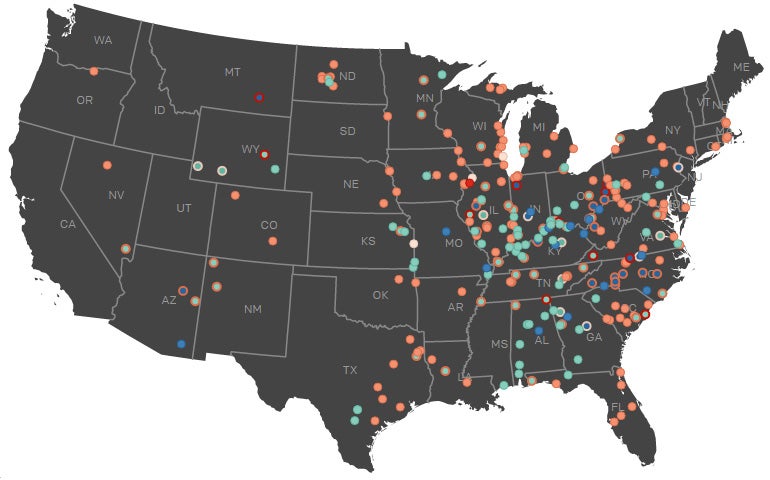Huge Win for Communities Threatened by Toxic Coal Pollution
A landmark court decision requires the EPA to significantly increase protections for more than 850 coal ash ponds.
Last week, the D.C. Circuit Court of Appeals handed a pivotal victory to environmental groups that will bring increased protection to hundreds of communities near leaking coal ash ponds across the nation. In a dramatic shift for industry and impacted communities, the court’s order requires EPA to strengthen protections for nearly 750 coal ash ponds, likely leading to the hastened closure of those toxic dumps. The order also directs EPA to draft rules for the closure and cleanup of more than 100 “legacy” ash ponds at retired coal plant sites, providing communities near shuttered coal plants with hope that they will not be forever left with toxic threats to their air and water. While it is far too early to know how the Trump EPA will respond to the court’s order, there is no ambiguity that the court is requiring EPA to establish many more, not fewer, protections at hundreds of utility sites.
EPA’s 2015 coal ash rule allowed more than 630 unlined coal ash ponds to continue to operate indefinitely despite overwhelming evidence that they are leaking dangerous pollution into groundwater, lakes and rivers. The 2015 rule also contained a loophole exempting from any protections more than 100 “legacy” ash ponds located at retired power plants that closed before the effective date of the rule. The court concluded that the rule’s provisions allowing unlined ash ponds to continue operating, as well as its exemptions for “legacy” ash ponds, fell short of statutory requirements to protect human health and the environment, and ordered EPA to strengthen the rule.
This ruling is potentially lifesaving for hundreds of communities near toxic ash ponds. Ever since coal plants started burning coal, utility companies have dumped toxic ash the cheapest way possible — by slurrying the mess into unlined earthen basins that often grew to contain millions of tons of hazardous sludge. More than 630 operating coal ash “ponds” across the country leak hazardous chemicals into drinking water, rivers, lakes and streams. Deadly chemicals in coal ash, including arsenic, chromium, lead, mercury, radium and selenium, can harm every major organ and cause cancer, heart disease, reproductive failure, stroke, inflict lasting brain damage on children, and kill fish and wildlife. In addition to threatening water sources, the earthen dams of these toxic ponds can catastrophically fail, as evidenced by the large-scale disasters in Harriman, Tennessee at the Kingston TVA Plant in 2008 and in North Carolina at the Duke Energy Dan River Station in 2014.
Some utilities may have rushed to close to avoid cleanup obligations of their toxic ponds. Now threatened communities near more than 100 legacy coal ash ponds may reap the benefits of last week’s decision, including:
- In Oakwood, Illinois, where unstable ponds at the retired Dynergy Vermilion Power Station leak toxic chemicals into Illinois’ only National Scenic River;
- In Lawrenceville, Indiana, where leaking ash ponds at AEP’s retired Tanners Creek Plant threaten to contaminate a public water system;
- In Milledgeville, Georgia, where coal ash ponds at Georgia Power’s retired Plant Harllee Branch leak toxic metals above health standards to groundwater near Lake Sinclair;
- In Richmond, Ohio where six coal ash ponds still sit at Duke Energy’s retired Walter Beckjord Plant;
- In Shamokin Dam, Pennsylvania, where an unlined, high hazard coal ash pond at WPS Energy Services’ retired Sunbury Generation Plant was rated in “poor” condition in a 2010 EPA assessment</a>;
- In Giles County, Virginia, where ponds at AEP’s retired Glen Lyn Power Station leaked toxic chemicals into the New River; and
- In Helper, Utah, where a coal ash spill in 2016 at the defunct Carbon Power Plant sent an unknown quantity of coal ash into the Price River.
The court order also requires EPA to address unlined ponds before utilities determine they are leaking. The implications are potentially huge since about 90 percent of the nation’s nearly 1000 ash ponds are unlined. A date-certain closure of these unlined ponds would be a giant step toward protecting the health and safety of nearby residents. We already know that more than 90 percent of coal ash ponds and landfills are leaking hazardous chemicals to groundwater above levels deemed safe for drinking, based on the monitoring data published by utilities last March.
The winds are shifting for coal ash. The court’s decision was issued only three weeks after the Trump EPA finalized a rule further weakening the 2015 coal ash rule by, among other things, extending the life of leaking, unlined ponds. Earthjustice will soon file a petition for review of this new Trump rule as it illegally fails to protect health and the environment.
Our federal courts play in an invaluable role in judging the legality of the Trump Administration’s attempts to gut environmental protections at the expense of public health. This court decision will provide greater protection of American communities from toxic coal ash, and serve as a shield against the Trump Administration’s efforts to reduce health and safety protections at coal ash dumps. The decision increases the likelihood of additional losses for the Trump camp in courts of law—demonstrating that litigation by Earthjustice and others can stop this administration’s attempts to illegally roll back essential health and environmental protections.
Hundreds of contaminated sites and spills have been documented among the 1,400+ coal ash waste dumps across the country. This map shows the known contamination at the time before industry began filing groundwater reports (click here for larger version). Industry-reported data is available here.
Earthjustice’s Clean Energy Program uses the power of the law and the strength of partnership to accelerate the transition to 100% clean energy.
